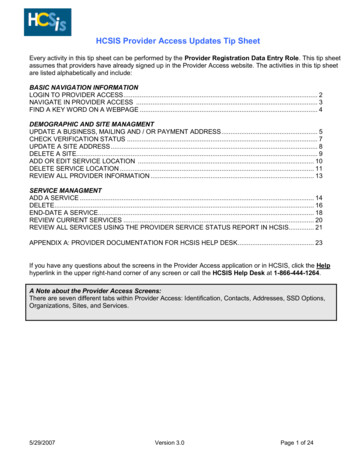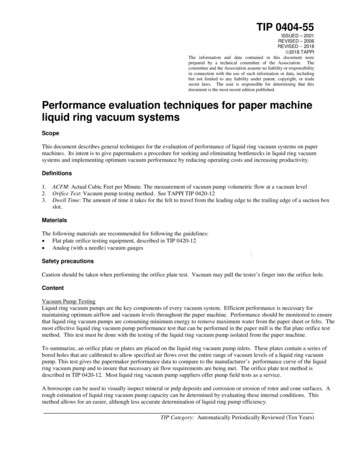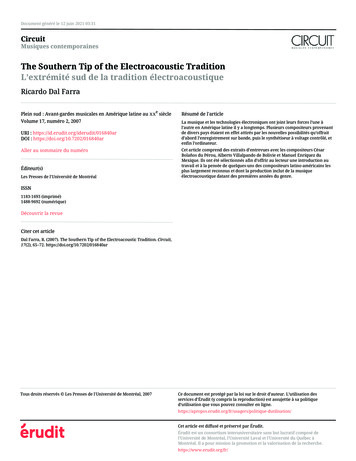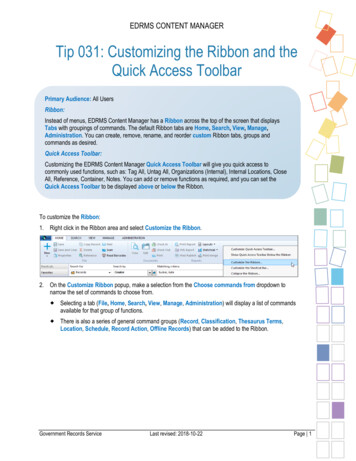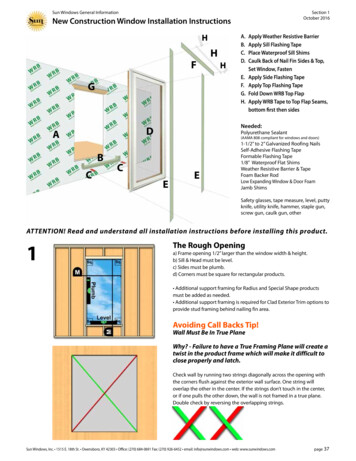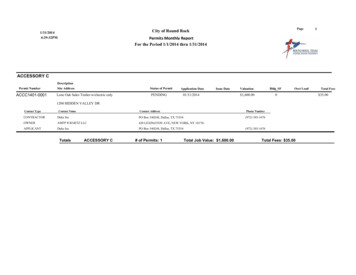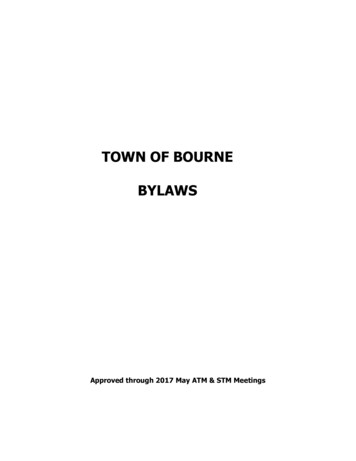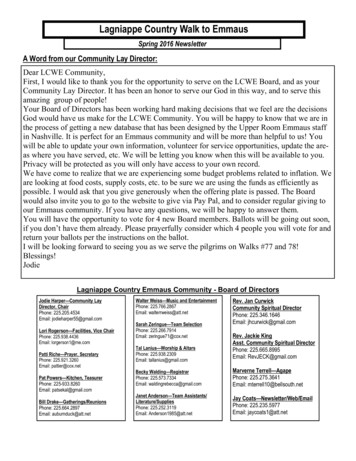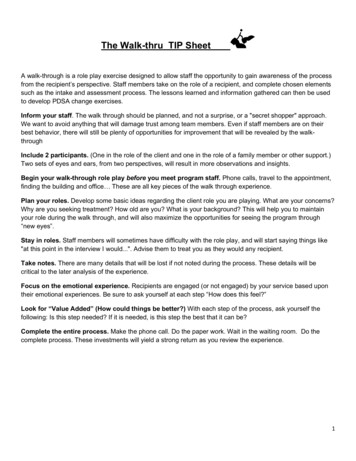
Transcription
The Walk-thru TIP SheetA walk-through is a role play exercise designed to allow staff the opportunity to gain awareness of the processfrom the recipient’s perspective. Staff members take on the role of a recipient, and complete chosen elementssuch as the intake and assessment process. The lessons learned and information gathered can then be usedto develop PDSA change exercises.Inform your staff. The walk through should be planned, and not a surprise, or a "secret shopper" approach.We want to avoid anything that will damage trust among team members. Even if staff members are on theirbest behavior, there will still be plenty of opportunities for improvement that will be revealed by the walkthroughInclude 2 participants. (One in the role of the client and one in the role of a family member or other support.)Two sets of eyes and ears, from two perspectives, will result in more observations and insights.Begin your walk-through role play before you meet program staff. Phone calls, travel to the appointment,finding the building and office These are all key pieces of the walk through experience.Plan your roles. Develop some basic ideas regarding the client role you are playing. What are your concerns?Why are you seeking treatment? How old are you? What is your background? This will help you to maintainyour role during the walk through, and will also maximize the opportunities for seeing the program through“new eyes”.Stay in roles. Staff members will sometimes have difficulty with the role play, and will start saying things like"at this point in the interview I would.". Advise them to treat you as they would any recipient.Take notes. There are many details that will be lost if not noted during the process. These details will becritical to the later analysis of the experience.Focus on the emotional experience. Recipients are engaged (or not engaged) by your service based upontheir emotional experiences. Be sure to ask yourself at each step “How does this feel?”Look for “Value Added” (How could things be better?) With each step of the process, ask yourself thefollowing: Is this step needed? If it is needed, is this step the best that it can be?Complete the entire process. Make the phone call. Do the paper work. Wait in the waiting room. Do thecomplete process. These investments will yield a strong return as you review the experience.1
Flow ChartsA visual map of the process, designed to show steps and transitions. It is helpful for finding bottle necks, roadblocks, and other challenges that prevent a smooth flow in the service process.These challenges are excellent targets for improvementFlawsFixesStepTransition?Step 1: Draw the first and last step of the process you would like to flow chart.Step 2: Fill in all the steps of the process (this can include decision steps by using diamonds).NOYESStep 3: Note any Flaws to the process: This step has elements that people complain about, this transitiontakes too long and leaves people waiting, etc. (Remember that flaws can be locatedin the steps and/or in the transitions.)Tip: draw theStep 4: Note any Fixes for the Flaws you have defined.steps on postit notes so thatStep 5: Use the flow chart along with other tools to consider next steps for improvementyou can moveprojects.them aroundas needed.2
Nominal Group TechniqueA brainstorming technique that will insure team member inclusionand the generation of a high volume of diverse ideas.Bad Brainstorming No structure/facilitation, a “free for all”. Has no focus, tends to wander across topics. Is dominated by the loudest/ most powerful. Discourages ideas through judgment or criticism. Creates warring factions and dissent. Generates the same old opinions.Good Brainstorming Is structured/facilitated by a leader. Is focused on a specific question or problem. Includes all participants. Encourages all ideas. Engages individuals in a team effort. Generates a wide range of new ideas.Nominal Group Technique (NGT) is Good BrainstormingThe 4 steps of NGT1. Silent Generation of ideas based on a strong question: Each individual generates their own list.Tip: use post-it notes: one idea per page.2. Round Robin Report and Record: Go around the room, one idea per person, record and number ideasas stated for all to see.Tip: Have each person read their idea as it is placed on the board/ sheet for all to see. Tip: Avoidediting the ideas.3. Discussion for Clarification: Questions are asked regarding the ideas shared. Insure that all membersunderstand all ideas.Tip: read all the ideas out load.4. Voting: Using sticky dots, a show of hands, or anonymous paper votes. Allow individuals to vote for anumber of items that encourages “tough choices”.Tip: Create simple criteria for voting. E.g. select the ideas that are “doable” and most likely to succeed.Tip: allow voting for 10-15 percent of the items, e.g. a list of 20 items might result in allowing 3 votesper member. Ask members to avoid placing all votes on one item.Tip: paper voting reduced peer pressure.3
Cause & Effect DiagramAlso known as the fishbone or the Ishikawa diagram, it is used to explore the root cause of a problem.Traditionally done in the shape of a fish, the facilitator asks a group to consider a problem, and then asks forthe causes of the problem, and the causes of the causes, until all potential root causes have been explored.Others prefer a hub and spoke approach, as it is easier to draw and expand with a group:Define the problem in a center circle and then draw a cause circle at each of the 4 compass headings. Ask thegroup to define at least these 4 causes (there may be more) and place them in the circles. Then explore thesub causes of these 4 causes, and continue until all causes have been explored.The result will be an inventory of granular root causes, some of which will be excellent targets Why don't they havetransportation?They have no car, they aresocially isolated, theydon't use the bus.CCWhy don't theyC use thebus?The bus is confusing, thebus costs too much, thebus schedule isinconvenient, they havechildren.So now we have movedfrom "Let’s fix the no showproblem", to "Let’s do bustraining, or provide bustokens". A much moreactionable agenda.CauseCCCCCauseWhy don't people show upfor the appointment?They forget, they areambivalent, they feelstigma, they don'thave transportation.CCC4
RAPID CYCLE PDSAAct What changesare to be madein next cycle?AbandonAdaptAdoptStudyPlan Objec ve Ques ons andpredic ons (why) Plan to carry outthe cycle (who,what, where, when)Do Complete the analysis Carry out the planof the data Document problems Compare data toand unexpectedpredic onsobserva ons Summarize Begin analysiswhat wasof the datalearned5
PDSA Critical QuestionsPLAN1. What is your Goal?2. What will you test and how will you test it?3. What questions are you trying to answer with this test?4. What do you expect will happen and why?5. How will you measure the results of this test?6. What data will you need to collect?7. Where will you collect the data? (What service/ clients?)8. When will you collect the data? (Start and stop date?)9. How will you collect the data?10. Who will collect the data?DO1.2.3.4.5.6.What are you learning as you go?What is going well?What problems have you had with the test?What has reprised you?What problems have you had collecting data?What is the data showing?STUDY1.2.3.4.What does the data tell you?What issues arose during the Do phase?How do the results compare to your prediction?What have you learned?ACT1.2.3.4.5.6.What did you learn from the study?Did you experience problems?Did you achieve your goal? (In part? In full?)If full achievement, are you ready to adopt?If partial, are you ready to adapt? (Next cycle ideas?)If failed, are you ready to abandon? (Consider a different test?)6
Rapid Cycle PDSAA data driven change implementation model10 Steps to ChangePre-Change StepsSTEP 1: Choosing a Goal-What do we want to improve?STEP 2: Choosing a Change-What change will lead to the desired improvement?STEP 3: Planning to MeasureProgress-How will we know if the change is working?Change Steps-What are the resources and activities needed?-How do we implement our plan?STEP 4: Plan the ChangeSTEP 5: Do the ChangeSTEP 6: Study the ResultsSTEP 7: Act on the Data & LessonsLearnedPost-Change StepsSTEP 9: Sustaining the ChangeSTEP 10: Spreading the ChangeStep 8: MultiplePDSA Cycles(as needed)-Can we adjust the change to makefurther progress toward the goal?-What have we learned?-What are our next steps?(Adopt, Abandon or Adapt the change)Adapted from*Langley, et al*NIATX workbook*IHI-How can we maintain the progress?-How can we spread a successful changeto a new team/ location?Adapted fromLangley, et al, NIATxWorkbook, & IHI7
A Simple Sequencing of ToolsForSuccessful Change implementationThere are many tools that can be used to successfully develop and implement change. The simple sequencebelow is designed to offer a concise road map that will work with most change projects, using some of themost commonly used and effective !Conduct a role play with staff to understand theexperience of your client/ customerDraw a flow chart map of the Walk-through experience including allof the steps, decision points, and transitions that you experienced.Conduct a Nominal Group Technique brain storm to generate and selectchange ideas to fix the flaws you found in the Walk Through and Flow Charting.Use the Change Form as a check list to plan out theChange project based upon your change idea.Complete a Rapid Cycle Plan-Do-Study-Act change to try toachieve your goals. Do multiple cycles if neededCelebrate the results of your change project. (This includes successfulresults, and lessons learned even if you did not achieve your goal)8
NOTES:9
Change Project FormProject Charter / Change Form.Name of Program / Team:1. Change Project Title2. Aim Statement (What is your Goal?)Aim Statement FormatIncrease or Decrease A from a Baseline of B to a Goal of C by DATE D.3. Location4. Identified start and end datesStart:End:5. Name of coalition or program)6. What customer population are youtrying to help?7. Executive Sponsor8. Change Leader9. Change Team(names and roles)10. How will you collect data to measurethe impact of change? Who will collectit?11. What is the expected impact of thischange project?How will the Executive Sponsor know? 2019 NIATx and the University of Wisconsin – Madison. All Rights Reserved.10
Change Project FormPDSA Cycles (add more as needed)PDSA Cycle #:Cycle Begin Date:Cycle End Date:What is the change to be tested?PPLAN: Plan the steps to carry out the cycle. Plan for data collection. What is your prediction for the test?DDO: Carry out the plan. Document observations. Record data.SSTUDY: Analyze the data. Compare results to predictions and pre-change data. Summarize what was learned.AACT: Will you adopt, adapt or abandon the change? Why? Move on to next cycle. 2019 NIATx and the University of Wisconsin – Madison. All Rights Reserved.11
Change Project FormPDSA Cycle #:Cycle Begin Date:Cycle End Date:What is the change to be tested?PPLAN: Plan the steps to carry out the cycle. Plan for data collection. What is your prediction for the test?DDO: Carry out the plan. Document observations. Record data.SSTUDY: Analyze the data. Compare results to predictions and pre-change data. Summarize what was learned.AACT: Will you adopt, adapt or abandon the change? Why? Move on to next cycle. 2019 NIATx and the University of Wisconsin – Madison. All Rights Reserved.12
Change Project FormEVALUATION AND SUSTAINABILIY PLANProject Outcomes (complete when project is finished)1. What was the project end date? (e.g.,when you stopped making changes)2. What did you learn? (e.g., what weresome lessons learned? Any unexpectedoutcomes from your change efforts?)3. What was the financial impact of thischange project? (e.g., Increasedvolunteer hours; Reduced staff time;etc.)Sustainability PlanA. Who is the sustain leader?B. What changes do you want to sustain?C. What sustain steps are being taken toensure that the changes stay in placeand that it is not possible to revert backto the old way of doing things?D. What is the target sustain measure?(i.e., if data drops below this point, theChange Team will intervene to get thingsback on track.)E. What system is in place to effectivelymonitor the sustain measure?Additional Notes: 2019 NIATx and the University of Wisconsin – Madison. All Rights Reserved.13
No structure/facilitation, a “free for all”. Has no focus, tends to wander across topics. Is dominated by the loudest/ most powerful. Discourages ideas through judgment or criticism. Creates warring factions and dissent. Generates the same old opinions. Good Brainstorming Is structured/facilitated by a leader.

